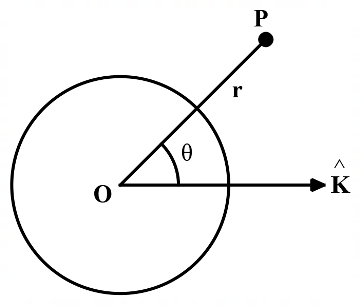Aspherical conductor of radius a is placed in a uniform electric field $$\overrightarrow {\bf{E}} = {E_0}\,{\bf{\hat k}}.$$ The potential at a point P(r, θ) for r > a, is given by $$\phi \left( {r,\,\theta } \right) = {\text{constant}} - {E_0}r\cos \theta + \frac{{{E_0}{a^3}}}{{{r^2}}}\cos \theta $$
where, r is the distance of P from the centre O of the sphere and θ is the angle, OP makes with the Z-axis.

The charge density on the sphere at θ = 30° is
A. $$3\sqrt 3 {\varepsilon _0}\,{E_0}/2$$
B. $$3{\varepsilon _0}\,{E_0}/2$$
C. $$\sqrt 3 {\varepsilon _0}\,{E_0}/2$$
D. $${\varepsilon _0}\,{E_0}/2$$
Answer: Option A
A. $$\frac{2}{{{\mu _0}}}\left( {x{\bf{\hat i}} + y{\bf{\hat j}}} \right)$$
B. $$ - \frac{2}{{{\mu _0}}}\left( {{\bf{\hat i}} + {\bf{\hat J}}} \right)$$
C. $$ - \frac{2}{{{\mu _0}}}\left( {{\bf{\hat i}} - {\bf{\hat j}}} \right)$$
D. $$\frac{2}{{{\mu _0}}}\left( {x{\bf{\hat i}} - y{\bf{\hat j}}} \right)$$
A. 0.033 μm
B. 0.330 μm
C. 3.300 μm
D. 33.000 μm
A. $${\bf{\hat z}}k$$
B. $${\bf{\hat x}}k\sin \alpha + {\bf{\hat y}}k\cos \alpha $$
C. $${\bf{\hat x}}k\cos \alpha + {\bf{\hat y}}k\cos \alpha $$
D. $$ - {\bf{\hat z}}k$$
A. vp = vg
B. vp = $${\text{v}}_{\text{g}}^{\frac{1}{2}}$$
C. vp vg = c2
D. vg = $${\text{v}}_{\text{p}}^{\frac{1}{2}}$$

Join The Discussion